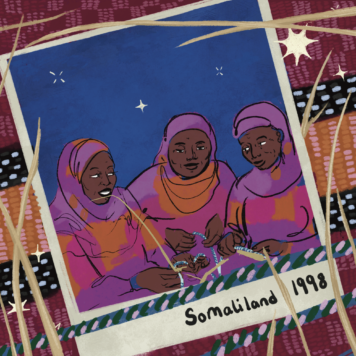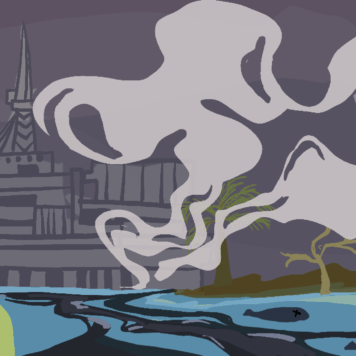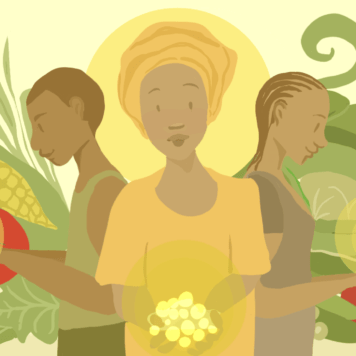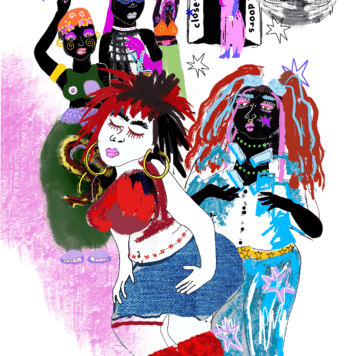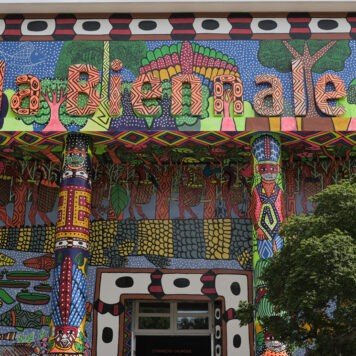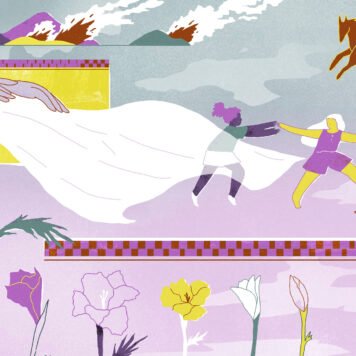Khalid Albaih is a Sudanese creative, political cartoonist, freelance journalist, art activist and cultural producer currently based in Doha. Khalid was born in Romania to a Sudanese diplomat and a social justice activist, and has lived in exile since the age of 11.
Despite living away from Sudan, Khalid is dedicated to uplifting his country’s stories and creatives. “Living in exile has undoubtedly shaped my artistic practice,” he tells me as we catch up on a call. “It has taught me the power of resilience and the importance of solidarity across borders. It continues to inform and enrich my artistic practice, urging me to be a catalyst for change.”
His works have been published across various international publications, websites and social media platforms, along with multiple widely acclaimed solo exhibitions. Some of his notable works were about the Arab Spring in 2011, which went viral across the Middle East and North Africa.
Khalid’s impactful cartoons provided insight into various aspects of the protests, including how the internet and citizen journalism transformed the protests’ dynamics. Brave individuals on the frontlines risked their lives to provide on-ground perspectives.
In fact, all Khalid’s works, from his cartoons (Khartoons, as he has coined them, after the Sudanese capital, Khartoum) to his articles, speak a lot about the complexity of the Middle East – particularly in resistance to the reductive portrayals and stereotypes by Western knowledge producers and their hegemonic control on how we see Middle Eastern issues.
The complicity of the West
Khalid mentions his inspiration to “challenge stereotypes and promote understanding through my art.” He rightly points out that the West often represents Middle Eastern politics in stereotypical ways, presenting these spaces as a mess to exonerate themselves from their complicity in the problem.
I’ve observed a similar issue in how Western states discuss queer rights in African countries. They often overlook their own role in shaping the laws that criminalise queer people, whether as a colonial legacy or through recent interventions. This portrayal recreates problems for queer people in African countries and fails to acknowledge that Western countries are not always safe havens for queer people either.
Khalid explains: “Whenever I do a cartoon about Sudan or write about Egypt or Palestine, I acknowledge that, yes, we are a mess. But you – the West – you are part of that mess.” This way of problematising the unrest in the Middle East avoids a one-dimensional look by acknowledging the existing issues while using lived experience and historical accounts to contextualise the problems in ways that reveal Western complicity.
The first of the more recent Sudanese civil wars began in 1955, a year before Sudan gained independence from Britain, pitting the central government against the Southern Sudan Liberation Movement (SSLM), with the UK supporting the central government. The conflict’s roots are multifaceted, but Western involvement has played a significant role.
The British colonial administration, known as the Anglo-Egyptian Condominium, fostered ethnic divisions between Northern and Southern Sudan, leading to post-independence conflicts. The British separated the two regions culturally and socially without political division. Consequently, when the British left, the Northern Sudanese were inclined to assimilate the Southerners forcibly, prompting resistance from the South.
The civil unrest continues and is particularly heightened at the time of writing, where rival military factions are fighting over control in a battle that has claimed hundreds of lives, injured thousands and displaced millions.
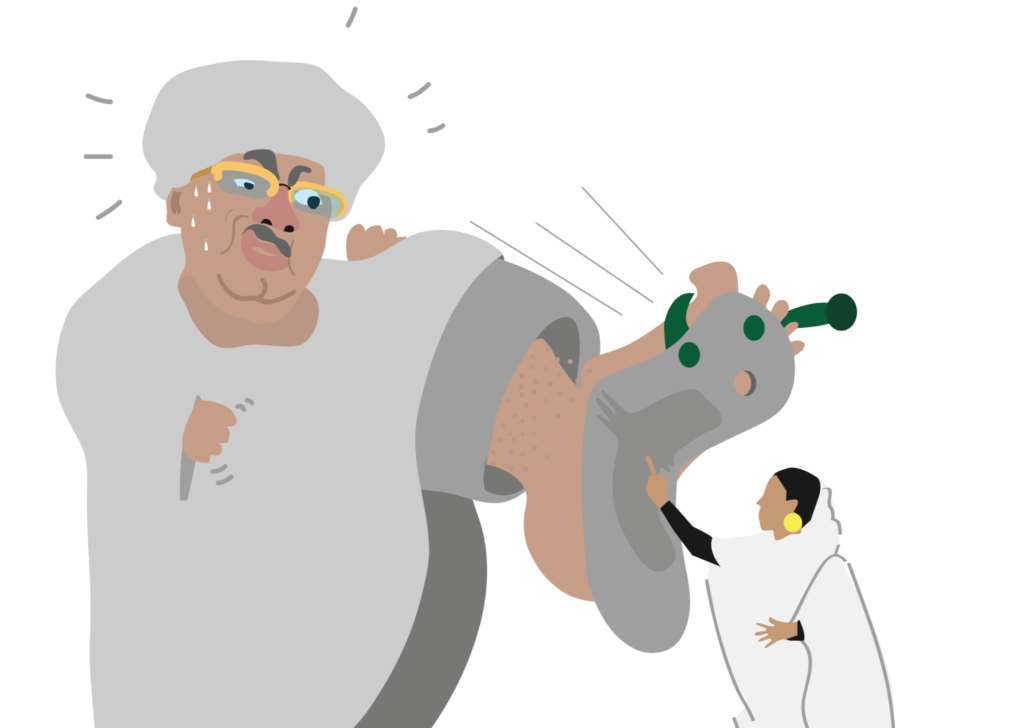
The simplicity and accessibility of Khartoons
Khalid conveys the complexities of these issues through a very simple medium: Khartoons. The minimalist nature of his Khartoons bear a complex message but are able to communicate this in an accessible way.
One of the most impactful pieces I found was I Hope Humanity Finds a Cure for Visas. In this piece, Khalid speaks to the fake and arbitrary borders we draw, and the increasingly strict immigration policies by various supposedly ‘free’ Western states. The piece symbolises the struggle refugees and people seeking asylum face when taking dangerous routes to find safety often leading to their deaths.
These Khartoons have served as a way for Khalid to “create art that challenges the status quo, sparks dialogue, and amplifies the voices of marginalised communities.” This is especially important for Khalid now. “In light of recent events, I feel an even greater urgency to use my platform to shed light on the struggles faced by the Sudanese people and to advocate for positive change,” he explains.
In the current Sudanese climate, people use art to “amplify their voices and shed light on the issues that matter most to them,” as Khalid has done. Another platform making waves is the Postcards from Khartoum page, showcasing a collection of images that give voice to Sudanese photographers and offer insights into their lives since 16th April 2023.
Sudanese artists are taking centre stage on social media and digital platforms, particularly during times of conflict. Their presence highlights their crucial role in representing diverse perspectives within these conflicts. Through their artistic expressions, they contribute to a deeper understanding of the ongoing struggles faced by the Sudanese people.
The intersection of art, the digital space and activism
Art plays a crucial role in social movements, serving as a powerful tool for expression and mobilisation. It can convey complex ideas, evoke emotions, and challenge prevailing norms and narratives, while empowering individuals and communities to challenge the status quo and envision alternative futures.
The digital space improves the accessibility of art because art often transcends language barriers. In a digital space with diverse languages and perspectives, art serves as a way to convey that message and allow it to travel beyond words.
I’ve observed a similar trend among queer artists and activists in Nigeria. They are utilising various art forms, such as filmmaking, creative art installations, exhibitions, and film festivals, to amplify their voices and add depth to their experiences. They use the digital space to amplify these art works to foster transnational solidarity and support.
Subscribe to shado's weekly newsletter
Exclusive event news, job and creative opportunities, first access to tickets and – just in case you missed them – our picks of the week, from inside shado and out.

Through these creative mediums, queer Nigerians can express their messages in subtle ways, allowing queerness to exist openly yet discreetly, hidden in plain sight. Art becomes a powerful tool for them to express themselves and share their stories with nuances
This makes Khalid’s work multilayered. Not only is he speaking to the redundancy of borders and boundaries in some of his works, but he is also doing so in a – relatively accessible – digital space. Utilising art in this context disrupts the boundaries around art and information accessibility.
“The importance of art and access to information in the current climate cannot be overstated,” he says. “In today’s interconnected world, where misinformation and disinformation spread rapidly, access to reliable and diverse sources of information becomes a vital safeguard for democracy, social progress, and I believe, a human right.”

The simplicity of the news
Issues of mis- and disinformation were at the core of mine and Khalid’s conversation. “We exist in the digital world where the news is now a cartoon.”
With the rising dependence on social media for our news, news sources must adapt to these formats to maintain relevance. Khalid has first-hand experience of this, as he now feels the need to create videos of himself drawing his cartoons – ”which is not my work” – to satiate Instagram’s punitive algorithms.
Media bias and the amplification of radicalised news on social networks for increased views and clickbait are pervasive. There is also biased reporting that fuels polarisation, while social networks contribute to echo chambers and clickbait prioritises sensational content over reliability.
This has led to an overload of simple and, importantly, shareable bits of information. Khalid believes that these “often simplify and sensationalise news stories, leading to a superficial understanding of events.”
On the reporting of recent events in Sudan, he adds: “there have been instances of both insightful and thought-provoking citizen journalism on social media, but sometimes this is lost in a sea of newly verified accounts.”
This has forced Khalid to rethink the power of cartoons. He explains, “I’m trying to sum up a complex issue in one panel that you can see, understand, and maybe research. This is now done through all media, including media that is supposed to be detailed, like the news. Everything fits in three-second videos now.”
It was refreshing to listen to Khalid recognise his ambivalence towards social media as someone who exists and participates in the space. He believes his Khartoons are beneficial because they act as a “diary of the times,” and are great archival tools. However, Khalid says, “With each day, I see that they’re not as powerful anymore.”
From the digital to the real world
The constant insecurity and headbutting with authoritarian regimes have also created a feeling of disillusionment and forced him to “take a step back and try to understand how to move forward.” He mentions how he has had to watch friends and colleagues get arrested and killed. He, himself, has received threats, and there is constant insecurity.
As artists and designers, he believes innovation and flexibility are vital in creating solutions. As such, he “started thinking outside of cartoons because they were a means to deliver a message; they were not the message.”
Consequently, Khalid decided to move away from his Khartoons and focus his efforts instead on building a public library in Sudan. He mentions how difficult it was to make people understand the importance of a public library. After all, Sudan already has university libraries, and there are spaces where you can buy books.
However, both these spaces present barriers to access through cost, the requirement for official passes, or, in the case of university libraries, literal police guards. For Khalid, it was essential to have a space where books are free, and a culture of trust was built by and for the community. “The state is denying us the information; we might as well just deliver the information by hand,” he explains.
I was curious about Khalid’s intentions to utilise the digital space with the library to increase its reach globally. He displays his disinterest by quoting American rapper Jack Harlow: “Ten toes, that’s my MO,” and continues, “I want to be on the ground and hold real books and have real conversations, and talk about things that are here now. Nothing has to do with the cloud. Nothing has to do with the digital at all.”
He recognises the importance of this in a space like Sudan, where disconnecting the internet is a tactic the government uses to silo people and deter their activism. He mentions how this encourages more people to come out and perform activism on the ground.
The recent mobilisation of resistance committees for access to shelter, medical aid, and rescue services in the current Sudan crisis highlights the critical role of social media in their efforts. However, these committees are not solely reliant on online platforms. They are actively combining their social media presence with on-ground actions.
Khalid wants to show these alternatives to reconceptualise recent narratives suggesting that activism can only happen with social media and the digital space.

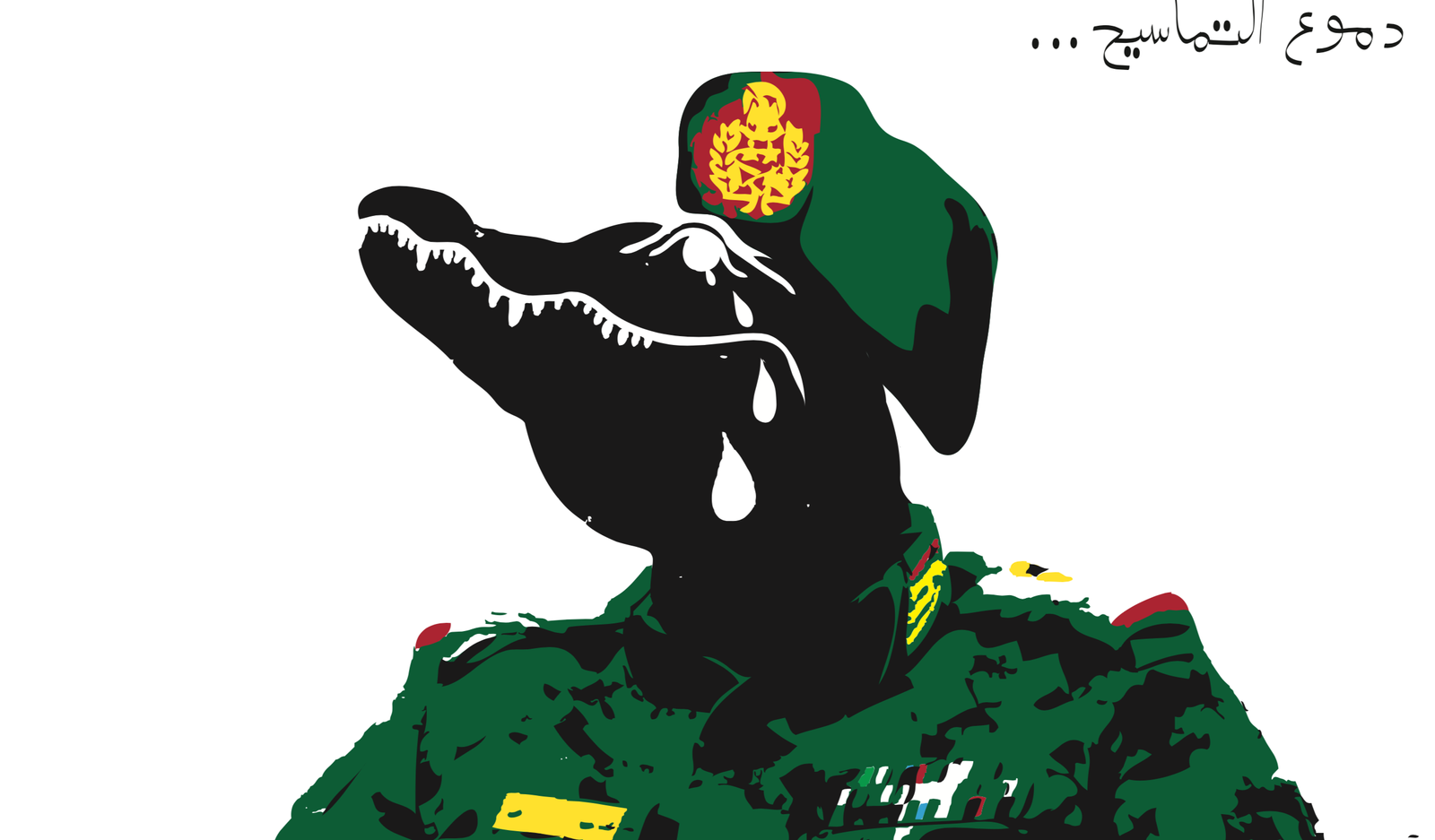
It’s not about the medium; it’s about the message: Khalid’s new Khartoons
However, this does not mean Khalid is entirely done with digital. He recognises its benefits and has found ways to utilise it. The digital space has been instrumental in him being able to run the library from outside of Sudan. “While physical distance separates me from the library, I’ve been planning for the past four years, and being outside gave me access and time to leverage digital platforms and collaborative efforts with international partners,” he explains. “I worked to curate a diverse collection of books, art, and resources that foster knowledge, creativity, and critical thinking.”
He also founded an award-winning app, Fadaa, which he mentions translates to space. Fadaa is a platform where you can donate spaces and facilities to your community for art shows and installations. It’s a way to make art accessible to everyone and anyone, and remove art from the hegemonic hands of elite spaces – instead making art part of the everyday world.
Fadaa goes beyond physical space; you can advertise to lend whatever you have, such as cameras and other equipment. It serves as a space for people with resources to share with others. As Khalid explains, “it’s not directed towards artists because artists always need spaces; it’s directed to people that want to give but don’t know how.”
Where the library was a space to find information and facilitate local knowledge production, Fadaa exists to accommodate you and set you up to work. For Khalid, “This is how I backed out… I think these are my new cartoons.”
These “new cartoons” have been instrumental in creating resources and space for artists in Sudan. This decentralises Khalid as a singular voice in that space and creates an opportunity to “get as many people doing things as possible.”
This led to him establishing the Sudan Artist Fund (SAF), which gives $500 to a Sudanese artist every month to do whatever they want to forward their craft. Khalid started this by using his money to buy a new computer for one of his favourite Sudanese video artists. He thought about how many other people were in that situation. “How is the resistance supposed to go on? Are my Khartoons going to be helpful? No, so the idea is to get as many people doing things as possible… They just need to apply.”
Khalid has given an artist $500 a month for about two years since then. It started with him giving his own money, but it has now grown into something sustained through crowdfunding – “so it’s a ‘for us, by us,’ kind of thing.”
This does not mean Khalid has stopped creating Khartoons, rather he has just diversified the way the message is delivered. And this message has stayed the same; he is still challenging authoritarian regimes, western influence on Middle Eastern politics, and drawing attention to the challenges of people and artists in the Middle East. However, he has found new ways to do these over the years that keep his works relevant and valuable.
I have recently been grappling with the idea of ambivalent actors in activist spaces. It is not always easy to recognise that you can, or have, become a part of a system you are critiquing, but Khalid shows us how to navigate that feeling and use it for a positive thing. He shows how we can sit with the discomfort of our ambivalence in ways that allow us to hold each other accountable while moving forward with innovative and organic ways to convey the message.
What can you do?
- Check out some of Khalid’s works
- Watch Sudan: History of a Broken Land
- Support the Sudan Artist Fund
- Check out the Postcards from Khartoum page (@khartoum.postcards on instagram) started and curated by Ala Kheir and André Lützen
- Read:
- Find out more about artists on the front lines of a changing Sudan here and here


